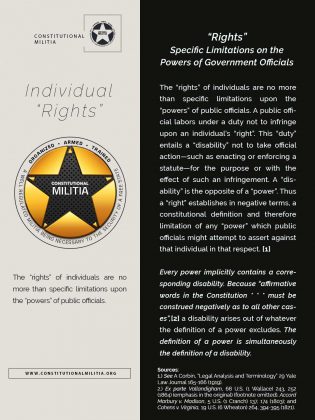Last Updated on March 8, 2023 by Constitutional Militia
“Further Declaratory and Restrictive Clauses”
The preamble to the Resolution which presented for ratification what became the Bill of Rights stated that, “in order to prevent misconstruction or abuse of [the Constitution’s] powers, * * * further declaratory and restrictive clauses should be added”—which by “extending the ground of public confidence in the Government, it will best ensure the beneficent ends of its institution”.
Source: RESOLUTION OF THE FIRST CONGRESS SUBMITTING TWELVE AMENDMENTS TO THE CONSTITUTION (4 March 1789), in Documents Illustrative of the Formation of the Union of the American States, House Document No. 938, 69th Congress, 1st Session (Washington D.C.: Government Printing Office, 1927), at 1063.
Bill of Rights: “further declaratory and restrictive clauses”
Were close attention paid to what the original Constitution actually provided, the Second Amendment would be recognized as something of a redundancy. The Second Amendment is one of the ten “further declaratory and restrictive clauses” that, compiled in the Bill of Rights, were “added” to the original Constitution “in order to prevent misconstruction or abuse of its [then existing] powers”.[1] When Alexander Hamilton wrote that the original “Constitution [wa]s itself, in every rational sense, and to every useful purpose, A BILL OF RIGHTS” as to the General Government,[2] he understated the matter, because the Constitution embodied “A BILL OF RIGHTS” as to the States, too. This was self-evident with respect to those provisions that explicitly prohibited the States from exercising certain powers or engaging in certain activities,[3] which the Supreme Court early on described as “a bill of rights for the people of each state”.[4] But it should also have been obvious with respect to the States’ powers that concerned the Militia.
The very purpose of the Second Amendment proved Hamilton correct. Primarily, the Amendment aimed at preventing “misconstruction * * * of [the original Constitution’s] powers”—that is, the “[w]rong interpretation of [its] words”.[5] Not at detracting from exorbitant powers that had been carelessly delegated to the General Government, but instead at ensuring that no error would occur in the application of the already properly limited powers that had been delegated. So, what the Amendment meant, the original Constitution meant as well. But because the original Constitution could and should have been construed consistently with the meaning of the Second Amendment in the first place, with the Amendment thereafter serving at the most as a mere guide to and confirmation of that construction, then the original Constitution could and should have been so correctly interpreted and applied even before the Amendment’s ratification, and even thereafter without the Amendment’s aid.[6]
On the face of the original Constitution, Congress’s power “[t]o provide for organizing arming, and disciplining, the Militia,”[7] referred to “the Militia of the several States” as they existed in 1788. A basic principle of “the Militia” in 1788, and for generations theretofore, was that everyone eligible for the Militia was to be “organized” in some manner, even those who might have qualified for exemptions from certain Militia duties. And because of the nature of the three purposes for which the Militia might have been “call[ed] forth” “in the Service of the United States”—especially “repel[ling] Invasions”[8] which might have threatened the very survival of the entire Union—under the original Constitution Congress should have “provide[d] for organizing, arming, and disciplining” everyone eligible for “the Militia” in some appropriate manner. That is, “the Militia” should have been composed of “the body of the people” as a whole.[9] Therefore, by definition, Congress’s power “[t]o provide for organizing * * * the Militia” excluded any license to decide, in some invidiously discriminatory fashion, who would or would not compose “the Militia”. In the guise of “organizing * * * the Militia”, Congress could not have jury rigged a “select militia”, with everyone else consigned to an “unorganized militia”(or to no “militia” at all)—whether the Second Amendment had existed or not.[10]
WE THE PEOPLE provide the ultimate, and the only really reliable, “checks and balances” in the constitutional system. “WE THE PEOPLE * * * ordain[ed] and establish[ed] th[e] Constitution”.[11] And “[t]he power to enact carries with it final authority to declare the meaning of the legislation”.[12] Moreover, “whenever a question arises between the society at large and any magistrate vested with powers originally delegated by that society, it must be decided by the voice of society itself: there is not upon earth any other tribunal to resort to.”[13] So, being absolutely superior to any and all public officials, whether civilian or military, THE PEOPLE enjoy an absolute right to require all public officials, whether civilian or military, to abide by THE PEOPLE’S construction of the Constitution. If that right is to be meaningful, however, a remedy must exist for its enforcement. Because “[a] right without a remedy is as if it were not. For every beneficial purpose it may be said not to exist.”[14] The Militia is that remedy.
Nothing could be more erroneous—and even destructive of the purpose of the Second Amendment as well as the Militia Clauses of the original Constitution—than the notions that not only does “the right of the people to keep and bear Arms” embrace an “individual right to possess and carry weapons in case of confrontation”, “having nothing whatever to do with service in a militia”, but also individual self-defense is “the central component of the right itself”.[15]
The competence of the Militia must be visualized as a spectrum akin to that of visible light—at the “red” end purely military and para-military functions; at the “blue” end, functions related to purely political, economic, and social “security”, such as the supervision of honest elections and the provision of an alternative constitutional currency; and in between, a multitude of functions encompassing enforcement of the laws and responses to exigent circumstances and novel dangers of one kind or another.

































